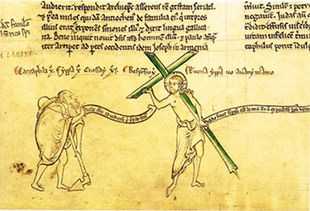
Matthew Paris, also known as Matthew of Paris, was an English Benedictine monk, chronicler, artist in illuminated manuscripts, and cartographer who was based at St Albans Abbey in Hertfordshire. He authored a number of historical works, many of which he scribed and illuminated himself, typically in drawings partly coloured with watercolour washes, sometimes called "tinted drawings". Some were written in Latin, others in Anglo-Norman or French verse. He is sometimes confused with the nonexistent Matthew of Westminster.
Thomas Walsingham was an English chronicler, and is the source of much of the knowledge of the reigns of Richard II, Henry IV, Henry V and the latter reign of Edward III depicting the decline of the state of affairs of the English. He also documented the careers of John Wycliff and Wat Tyler.
Roger of Wendover, probably a native of Wendover in Buckinghamshire, was an English chronicler of the 13th century.

The Flores Historiarum is the name of two different Latin chronicles by medieval English historians that were created in the 13th century, associated originally with the Abbey of St Albans.
Sir John Maunsell, Provost of Beverley Minster, was a king's clerk and a judge. He served as chancellor to King Henry III and was England's first secretary of state.
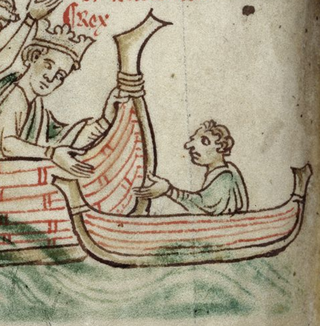
Nicholas de Moels or Nicholas Molis was an Anglo‑Norman royal administrator and household knight of King Henry III of England. In this capacity he was assigned many and varied offices and duties, often of a temporary nature. He married a wealthy heiress from North Cadbury in Somerset which transformed him into a major landholder and feudal baron. In 1244 whilst serving as Seneschal of Gascony, he inflicted a defeat on the King of Navarre, whom he took prisoner in the field.

William III de Cantilupe was the 3rd feudal baron of Eaton Bray in Bedfordshire, and jure uxoris was feudal baron of Totnes in Devon and Lord of Abergavenny. His chief residences were at Calne in Wiltshire and Aston Cantlow, in Warwickshire, until he inherited Abergavenny Castle and the other estates of that lordship.

Æscwine or Erkenwine is listed in some Anglo-Saxon royal genealogies as the first king of Essex and father of Sledd. Most sources list Sledd as the first king and Æscwine's existence is uncertain.
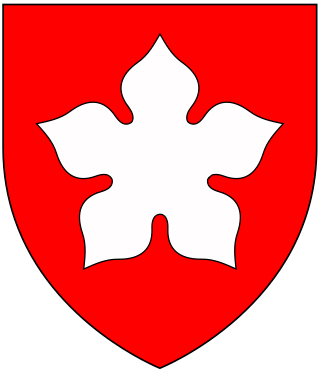
Sir Falkes de Bréauté was an Anglo-Norman soldier who earned high office by loyally serving first King John and later King Henry III in the First Barons' War. He played a key role in the Battle of Lincoln Fair in 1217. He attempted to rival Hubert de Burgh, and as a result fell from power in 1224. His "heraldic device" is now popularly said to have been a griffin, although his coat of arms as depicted by Matthew Paris in his Chronica Majora was Gules, a cinquefoil argent.

John of Wallingford, also known as John de Cella, was Abbot of St Albans Abbey in the English county of Hertfordshire from 1195 to his death in 1214. He was previously prior of Holy Trinity Priory at Wallingford in Berkshire, a cell of St Albans.
Gerard la Pucelle was a peripatetic Anglo-French scholar of canon law, clerk, and Bishop of Coventry.

The Parker Library is a library within Corpus Christi College, Cambridge which contains rare books and manuscripts. It is known throughout the world due to its invaluable collection of over 600 manuscripts, particularly medieval texts, the majority of which were bequeathed to the college by Archbishop of Canterbury Matthew Parker, a former Master of Corpus Christi College.
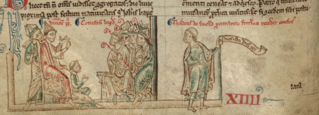
Taddeo da Suessa was an Italian jurist.
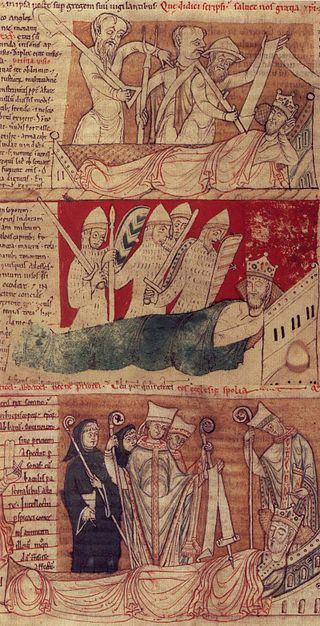
John of Worcester was an English monk and chronicler who worked at Worcester Priory. He is usually held to be the author of the Chronicon ex chronicis.

The Vitae duorum Offarum "The lives of the two Offas" is a literary history written in the mid-thirteenth century, apparently by the St Albans monk Matthew Paris; however, the most recent editor and translator of the work rejects this attribution and argues for an earlier date, in the late twelfth century. The earliest editor, William Wats, argues that the texts are older than Matthew's day but were revised by him; he bases this view on stylistic elements, such as the inclusion in the first Vita of a quotation from Lucan which also appears repeatedly in Matthew's Chronica maiora.

The House of Braose was a prominent family of Anglo-Norman nobles originating in Briouze, near Argentan, Orne, Normandy. Members of this family played a significant part in the Norman conquest of England and subsequent power struggles in England, Wales and Ireland in the 11th to 14th centuries.

John of Wallingford was a Benedictine monk at the Abbey of St Albans, who served as the abbey's infirmarer at some time between c.1246-7 and his death in 1258. He is now mostly known through a manuscript containing a miscellaneous collection of material, mostly written up by Wallingford from various works by his contemporary at the abbey Matthew Paris, which survives as British Library Cotton MS Julius D VII. This manuscript includes the so-called Chronica Joannis Wallingford or Chronicle of John of Wallingford.
Gervase of Melkley or Gervase of Melkeley was an Anglo-Norman scholar and poet.
Philippa Mary Hoskin is a British historian of the English Middle Ages, who specializes in the religious, legal and administrative history of the English Church. She is the Fellow Librarian of the Parker Library, Corpus Christi College, Cambridge.

